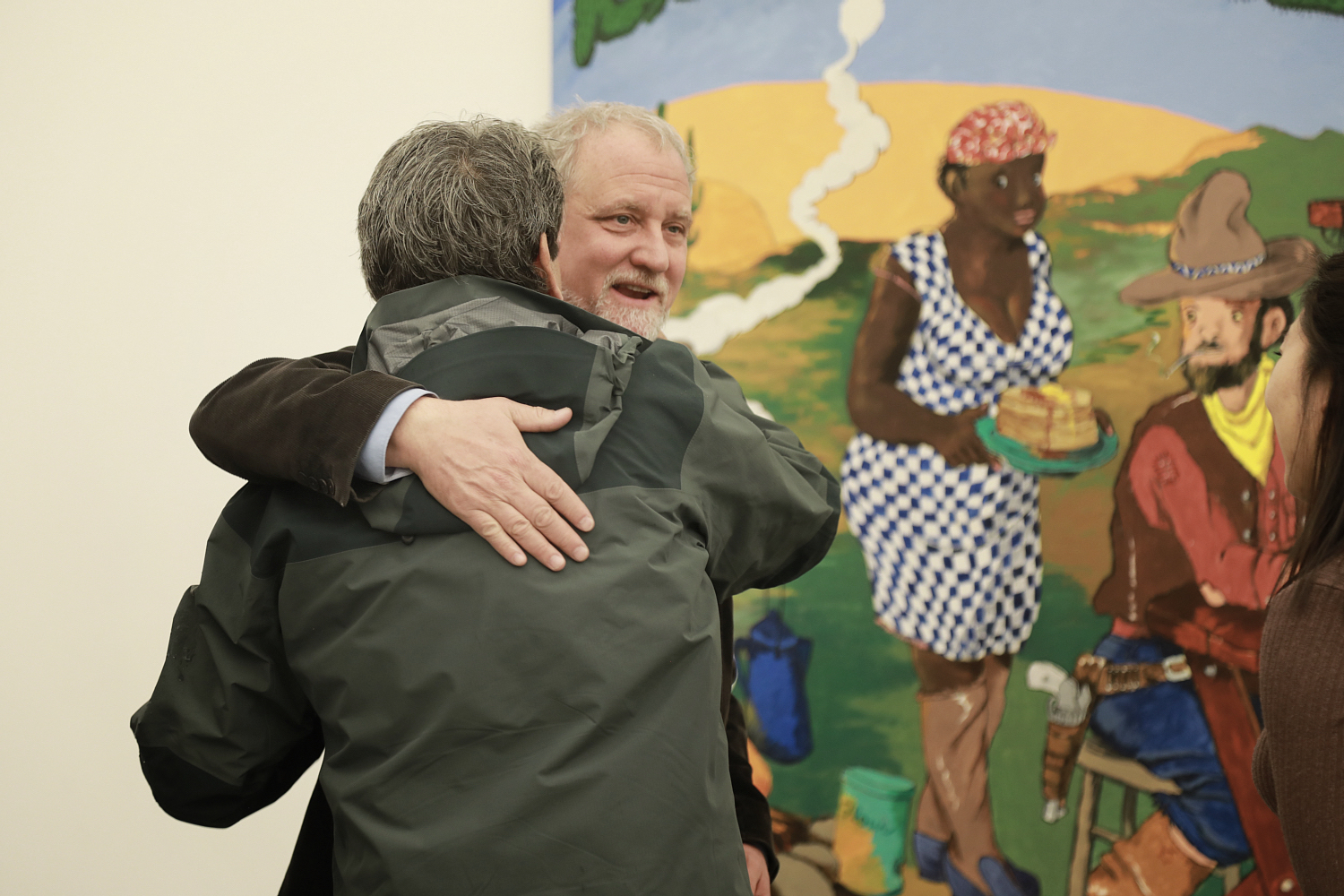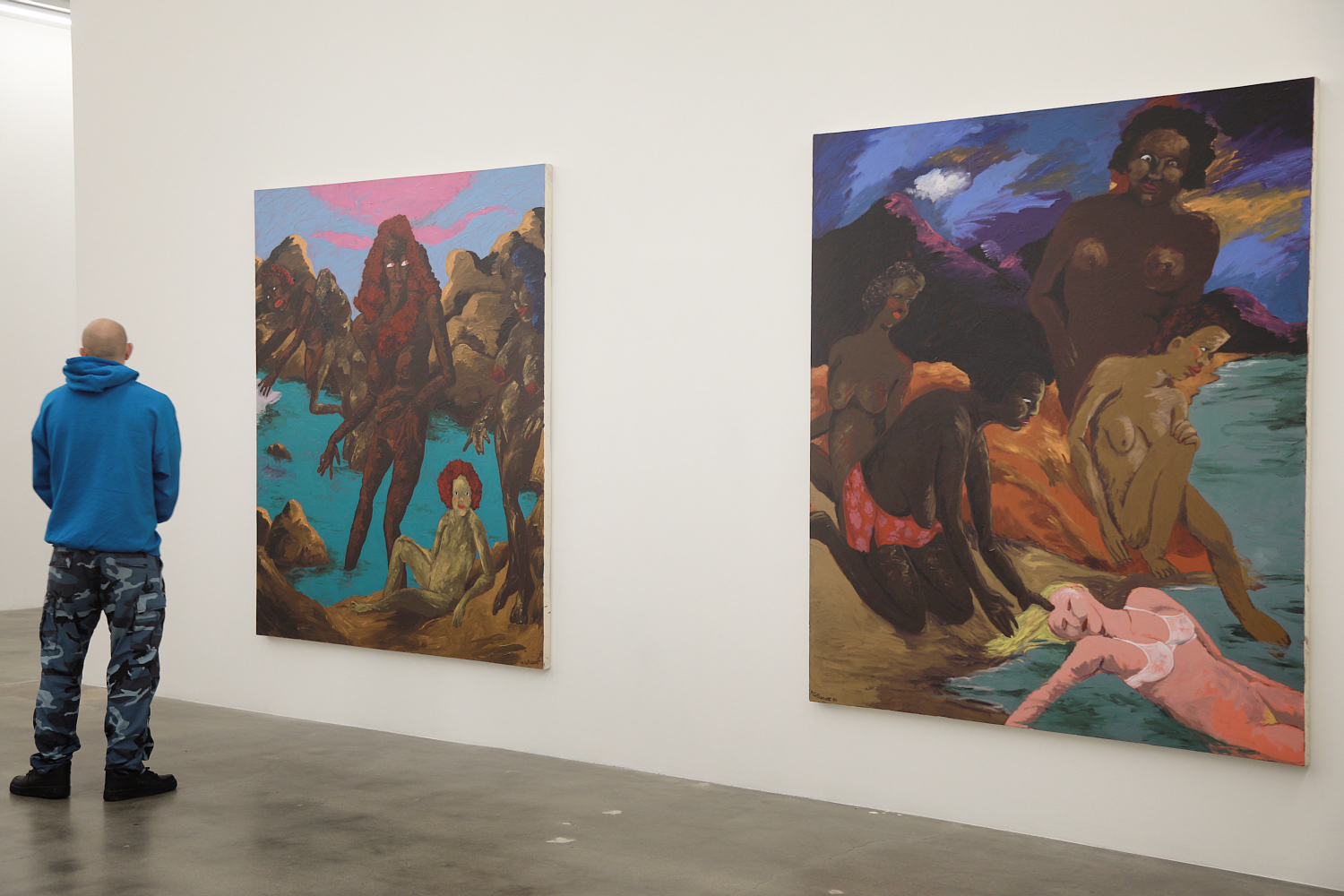Robert Colescott
Blum & Poe, Los Angeles
March 10—April 28, 2018
“Blum & Poe is pleased to present an exhibition of paintings and drawings by Robert Colescott (b. 1925, Oakland, CA; d. 2009, Tucson, AZ). This exhibition represents the first significant overview of Colescott’s work in Los Angeles, and the most comprehensive selection of paintings and drawings to be on view in California in over twenty years.
Over a nearly six-decade career, Robert Colescott established himself as a singular voice in American painting. With his distinctive style of figuration, Colescott laid bare issues of systemic racism and the omission of black subjects within the genre of history painting—offering up a disturbing yet poignant critique of male chauvinism, sexual misconduct, and interracial relationships. The exhibition at Blum & Poe is organized thematically, with individual galleries dedicated to many of these subjects that permeated Colescott’s work for much of his life. A forthcoming catalogue with new scholarly essays will follow this exhibition.
Works on view foregrounding Colescott’s interest in politics and current affairs include Kitchen Assassination (1971), a chaotic composition depicting the 1968 shooting of Robert F. Kennedy at the Ambassador Hotel, and its corresponding painting, Assassin Down (1968-70), illustrating the shooting of Lee Harvey Oswald. These works, along with more historical representations of war and strife, such as El Mahdi (1968-70) and Pancho Villa (1971), illustrate Colescott’s attraction not only to his own American story, but also to the stories and histories of other cultures. Of particular note, El Mahdi was painted after Colescott’s time as the first professor of painting at the American University in Cairo, Egypt in 1966-67. This experience proved to be formative for the artist, as he stated, “Egypt submerged me in my non-European identity.” This exposure to myriad cultures and art forms would later aid Colescott in forming his own uniquely “American” style of painting and storytelling. Colescott’s aesthetic maintained elements of Pop art and formally conjured both the Chicago Imagists and the Bay Area Figurative painters (art historical movements which coincided with his own artistic maturation period). His work has defined itself largely through its bracingly satirical sensibility and biographical nature.
Beginning in the 1970s, while holding various teaching positions in the Bay Area and Pacific Northwest, Colescott focused his attention repeatedly on the subject of sex—specifically interracial relations and the perceived power dynamic between men and women of that time. These issues—which would hold a place of prominence in Colescott’s work for decades—viewed now forty years later, have proven to be tremendously topical and relevant in this moment of national reckoning. In Colescott’s satirical fashion, paintings such as Fears: the Big Bad Wolf (1973) and Peeping Tom (1973), take a self-aware view of the male gaze and through parody address such dark stereotypes as the perceived danger of black men to white women, and sexual misconduct in the workplace.
By fearlessly appropriating masterworks from art history and offering a revisionist narrative with black men and women in positions of prominence, Colescott subverted centuries of preconceived tradition in Western culture. On view are key works from Colescott’s “Bathers” series (1984-85), which place black protagonists into the foreground of classical turn of the century paintings by Renoir and Cézanne, immediately shifting one’s understanding of perceived beauty, power, and historical accuracy in the canon of Western painting. For much of the 1970s, ‘80s and into the ‘90s, Colescott would offer this reassessment of art history in such iconic works as George Washington Carver Crossing the Delaware: Page from an American History Textbook (1975). Here, Colescott upends Emanuel Leutze’s famous 1851 portrait of George Washington, recasting the expedition with a black Carver at the helm of the boat in Washington’s stead.
Colescott’s late work, executed while living and teaching in Arizona, shows an artist still focused on depicting historical painting through his own lens, yet with a looser and more gestural compositional style. One work on view, W.M.D.: Remembering Sardanapalus (2004-06), is adapted from Delacroix’s Death of Sardanapalus (1827). As the title would suggest, here Colescott is making a commentary on the invasion of Iraq during the Bush administration tenure, hence reminding his viewer as he has done so many times before, that history always finds a way of repeating itself. As observed by the curator Daniel Cornell, “In this late work, the delight of unrestrained laughter which has accompanied so much of the artist’s best work, is buttressed by his refusal to allow subject matter to dictate the constraints of his painted surfaces.”
Robert Colescott’s work is represented in the public collections of such notable institutions as the Brooklyn Museum of Art; High Museum of Art, Atlanta; Metropolitan Museum of Art, New York; Museum of Modern Art, New York; National Gallery of Art, Washington, D.C.; San Francisco Museum of Modern Art; Studio Museum in Harlem, New York; Wadsworth Atheneum, Hartford, CT; Walker Art Center, Minneapolis; and the Whitney Museum of American Art, New York, amongst many others.
In 1997, Robert Colescott was honored as the first African American artist to represent the United States with a solo exhibition at the 47th Venice Biennale. The presentation at Blum & Poe coincides with Figuring History: Robert Colescott, Kerry James Marshall, Mickalene Thomas at the Seattle Art Museum; The Long Run at the Museum of Modern Art, New York, an exhibition celebrating artists who have practiced sustained critical thinking and persistent observation; and will precede a traveling retrospective curated by Lowery Stokes Sims beginning at the Contemporary Arts Center, Cincinnati in late 2019.”

